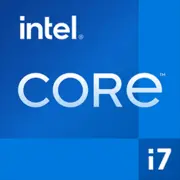Intel Core i7-11700T

Intel Core i7-11700T: Overview and Practical Guide for 2025
Current as of April 2025
Key Features: Architecture and Performance
Code Name and Process Technology
The Intel Core i7-11700T belongs to the Rocket Lake-S generation and is manufactured using a 14nm process. Despite the "age" of the architecture, it remains relevant due to power consumption optimization and support for modern interfaces. Key features include:
- 8 cores and 16 threads with a base frequency of 1.4 GHz and Turbo Boost up to 4.6 GHz.
- 16 MB of L3 cache, which speeds up the processing of multithreaded tasks.
- Integrated graphics UHD Graphics 750 with 32 execution units (EU).
- Support for PCIe 4.0 (up to 20 lanes), which is relevant for NVMe drives and mid-range discrete GPUs.
Performance
According to Geekbench 6, the processor demonstrates:
- 1698 points in single-threaded mode — sufficient for office applications and light gaming.
- 6500 points in multi-threaded mode — suitable for rendering, video encoding, and virtualization.
Energy Efficiency
A TDP of 35W makes it ideal for compact PCs and systems with passive cooling. However, under peak loads, power consumption can reach 70-80W, requiring a thoughtful approach to cooling.
Compatible Motherboards: Choosing Chipsets and Sockets
Socket LGA 1200
The processor uses the LGA 1200 socket, which is supported by the 500 series chipsets:
- Z590 — for enthusiasts: RAM overclocking, PCIe 4.0 x8/x8 for SLI/CrossFire (price: $200–$300).
- B560 — the optimal option: PCIe 4.0 support for GPUs and NVMe, unlocked multiplier for RAM (example: ASUS TUF B560-Plus, $130–$160).
- H510 — budget boards: suitable for office builds, but limited to PCIe 3.0 and lack of memory overclocking (price: $70–$100).
Recommendations
- For maximum performance, choose Z590 motherboards with VRM modules equipped with heatsinks (e.g., MSI Z590-A Pro).
- Avoid cheap H510 boards when using PCIe 4.0 drives — they will not unlock their potential.
Supported Memory: DDR4 and Configuration Tips
Types of Memory
The i7-11700T works only with DDR4 (up to 3200 MHz in Gear 1 mode). DDR5 support is absent, which may be considered a disadvantage in 2025.
Configuration Recommendations
- Optimal volume: 32 GB (2×16 GB) for work tasks.
- For gaming and multimedia, 16 GB (2×8 GB) is sufficient.
- Choose modules with low timings (CL16–CL18) — this will improve system responsiveness.
Limitations
On H510 and B560 chipsets, RAM frequency may be limited to 2933 MHz. On Z590, manual overclocking is available up to 4000+ MHz, but stability depends on memory quality.
Power Supply Units: Power Calculation
System Power Consumption
- The processor itself: up to 80W under load.
- Integrated graphics: adds 15–20W.
- With a discrete graphics card (e.g., NVIDIA RTX 3060): +170W.
Recommendations
- For systems without discrete graphics: PSU rated 300–400W (e.g., be quiet! Pure Power 11 400W, $60).
- With mid-range GPUs: 500–600W (Corsair CX650M, $80).
- Always opt for a PSU with an 80+ Bronze certification or higher — this ensures stability and efficiency of at least 85%.
Pros and Cons of the Processor
Strengths
- Energy efficiency: suitable for mini PCs and home servers.
- Strong multithreading: competes with Ryzen 7 5700G in rendering.
- Integrated graphics: UHD 750 handles 4K video and light gaming (e.g., Dota 2 at medium settings).
Weaknesses
- 14nm process technology: lags behind AMD in energy efficiency under peak loads.
- Lack of PCIe 5.0 and DDR5: not suitable for future-proof upgrades.
- Price: in 2025, the new i7-11700T costs about $250, while the Ryzen 5 7600 with DDR5 can be found for $300.
Use Cases
Office and Multimedia
- Streaming 4K video, working with documents, and browsing with dozens of tabs — the processor does not lag even under multitasking.
Work Tasks
- Video editing in Premiere Pro, 3D modeling in Blender — 16 threads speed up rendering.
- Virtualization: running 2–3 virtual machines simultaneously without lag.
Gaming
- With a discrete graphics card (e.g., RTX 3060 Ti): comfortable gaming at Full HD on high settings.
- On integrated graphics: CS:GO — 60 FPS, GTA V — 40–50 FPS (on low settings).
Comparison with Competitors
AMD Ryzen 7 5700G
- Pros: 7nm process technology, more powerful Vega 8 graphics, PCIe 4.0 support.
- Cons: lower single-threaded performance (Geekbench 6 Single-Core: ~1500).
- Price: $220–$240 (new, 2025).
Intel Core i5-13400
- Pros: 10-core hybrid design, DDR5, PCIe 5.0.
- Cons: TDP 65W, higher price ($280).
Conclusion: The i7-11700T excels in budget builds with a focus on multithreading but lags in "new" technologies.
Practical Assembly Tips
1. Cooler: Even with a TDP of 35W, it’s advisable to use a tower cooler (e.g., DeepCool GAMMAXX 400 V2) — it will reduce noise and temperature under load.
2. Drives: Opt for NVMe SSDs with PCIe 4.0 (Samsung 980 Pro) — this will unlock the processor's potential.
3. Case: Compact cases with ventilation (Fractal Design Node 304) are suitable for passive cooling.
Final Conclusion: Who Should Consider the i7-11700T?
This processor is worth choosing for:
- Energy-efficient systems: media centers, office PCs, home servers.
- In budget workstations: video editing, programming, virtualization.
- If DDR5 and PCIe 5.0 are not needed: relevant for those who do not plan to upgrade in the next 3-4 years.
In 2025, the i7-11700T remains a niche solution, but its price and performance are justified for specific tasks. However, if you want to "future-proof," consider newer models with DDR5 support.
Basic
CPU Specifications
Memory Specifications
GPU Specifications
Benchmarks
Compared to Other CPU
Share in social media
Or Link To Us
<a href="https://cputronic.com/en/cpu/intel-core-i7-11700t" target="_blank">Intel Core i7-11700T</a>